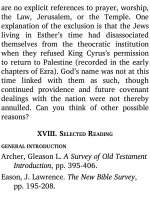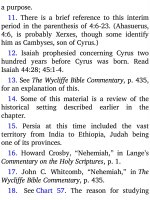Jensens survey of the old testament adam 55
Bạn đang xem bản rút gọn của tài liệu. Xem và tải ngay bản đầy đủ của tài liệu tại đây (257.35 KB, 4 trang )
the dateline.
3. Read Exodus 1:7. Where on Chart 12 is
this verse dated?
4. Read Exodus 1:8. There are two
di erent views as to the identity of this
“new king.” View identi es him as one of
the Hyksos rulers. 4 According to View , the
“new king” was Amose I, the rst of the
eighteenth dynasty.5 The main practical
di erence between the two views is the
duration of Israel’s oppression.
5. The date of the Exodus is shown as
1445 B.C.6 This is derived from two sets of
facts:
6. How soon after the Exodus was the
wilderness tabernacle completed?
7. Note how much Israelite history had
transpired before the birth of Moses. Does
this suggest to you any spiritual lessons?
D. GEOGRAPHY
Map F shows where the action of Exodus
took place. Learn this geography so that you
can visualize the book’s narrative. Note the
location of Goshen. This is where the
Israelites were dwelling in Egypt. Read
Exodus 8:22 and 9:26.
III. SURVEY
1. Begin your study of the text of Exodus
by scanning the forty chapters of the book in
one sitting. Look at each chapter just long
enough to identify its general content. Don’t
read every verse, nor tarry over details. The
rst verse of each chapter is often a clue to
the chapter’s message. Also, your Bible may
show general content at the top of each
page. The purpose of this initial scanning is
to get the “feel” of the book and observe its
“ ow” or progression. Always keep a pencil
in your hand as you survey the text, and feel
free to make notations in your Bible. Write
down on a sheet of paper your impressions
thus far, and record any key words or
phrases that have stood out from the text.
2. Now go back to each chapter and
secure from the text of each chapter a
picturesque word or short phrase which will
represent a leading thought in the chapter.
Record your forty chapter titles on a chart
similar to the following:
When you have done this, you will have a
fair grasp of at least the large movements or
groups of material in Exodus.
For help in completing the remaining
study suggestions and questions, refer to
these chapter titles as well as the text of the









